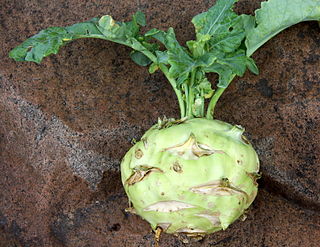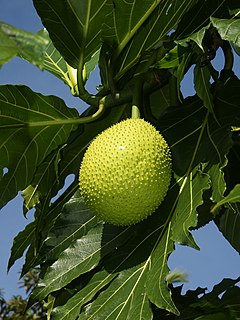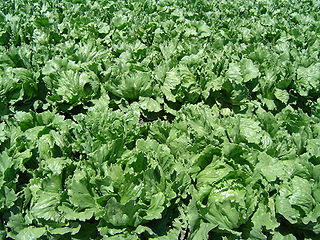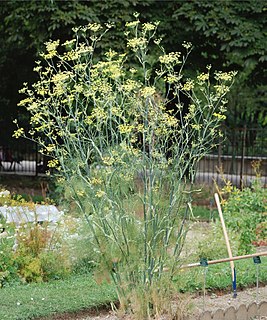
Kohlrabi, also called German turnip, is a biennial vegetable, a low, stout cultivar of wild cabbage. It is another cultivar of the same species as cabbage, broccoli, cauliflower, kale, Brussels sprouts, collard greens, Savoy cabbage, and gai lan.

Breadfruit is a species of flowering tree in the mulberry and jackfruit family (Moraceae) believed to be a domesticated descendant of Artocarpus camansi originating in New Guinea, the Maluku Islands, and the Philippines. It was initially spread to Oceania via the Austronesian expansion. It was further spread to other tropical regions of the world during the Colonial Era. British and French navigators introduced a few Polynesian seedless varieties to Caribbean islands during the late 18th century. Today it is grown in some 90 countries throughout South and Southeast Asia, the Pacific Ocean, the Caribbean, Central America and Africa. Its name is derived from the texture of the moderately ripe fruit when cooked, similar to freshly baked bread and having a potato-like flavor.

Lettuce is an annual plant of the daisy family, Asteraceae. It is most often grown as a leaf vegetable, but sometimes for its stem and seeds. Lettuce is most often used for salads, although it is also seen in other kinds of food, such as soups, sandwiches and wraps; it can also be grilled. One variety, the celtuce, is grown for its stems, which are eaten either raw or cooked. In addition to its main use as a leafy green, it has also gathered religious and medicinal significance over centuries of human consumption. Europe and North America originally dominated the market for lettuce, but by the late 20th century the consumption of lettuce had spread throughout the world. As of 2017, world production of lettuce and chicory was 27 million tonnes, 56% of which came from China.

Common chicory is a somewhat woody, perennial herbaceous plant of the daisy family Asteraceae, usually with bright blue flowers, rarely white or pink. Many varieties are cultivated for salad leaves, chicons, or roots, which are baked, ground, and used as a coffee substitute and food additive. In the 21st century, inulin, an extract from chicory root, has been used in food manufacturing as a sweetener and source of dietary fiber.

The radish is an edible root vegetable of the family Brassicaceae that was domesticated in Asia prior to Roman times.

Fennel is a flowering plant species in the carrot family. It is a hardy, perennial herb with yellow flowers and feathery leaves. It is indigenous to the shores of the Mediterranean but has become widely naturalized in many parts of the world, especially on dry soils near the sea-coast and on riverbanks.

Vicia faba, also known in the culinary sense as the broad bean, fava bean, or faba bean, is a species of vetch, a flowering plant in the pea and bean family Fabaceae. It is widely cultivated as a crop for human consumption, and also as a cover crop. Varieties with smaller, harder seeds that are fed to horses or other animals are called field bean, tic bean or tick bean. Horse bean, Vicia faba var. equinaPers., is a variety recognized as an accepted name.

Endive is a leaf vegetable belonging to the genus Cichorium, which includes several similar bitter-leafed vegetables. Species include Cichorium endivia, Cichorium pumilum, and Cichorium intybus. Common chicory includes types such as radicchio, puntarelle, and Belgian endive.

The zucchini, courgette or baby marrow is a summer squash, a vining herbaceous plant whose fruit are harvested when their immature seeds and epicarp (rind) are still soft and edible. It is closely related, but not identical, to the marrow; its fruit may be called marrow when mature.

Radicchio is a perennial cultivated form of leaf chicory sometimes known as Italian chicory because of its common use in Italian cuisine. It is grown as a leaf vegetable and usually has colorful white-veined red leaves that form a head. Radicchio has a bitter and spicy taste which mellows if it is grilled or roasted.

Leaf vegetables, also called leafy greens, salad greens, pot herbs, vegetable greens, or simply greens, are plant leaves eaten as a vegetable, sometimes accompanied by tender petioles and shoots. Although they come from a very wide variety of plants, most share a great deal with other leaf vegetables in nutrition and cooking methods.

Chenopodium is a genus of numerous species of perennial or annual herbaceous flowering plants known as the goosefoots, which occur almost anywhere in the world. It is placed in the family Amaranthaceae in the APG II system; older classification systems, notably the widely used Cronquist system, separate it and its relatives as Chenopodiaceae, but this leaves the rest of the Amaranthaceae polyphyletic. However, among the Amaranthaceae, the genus Chenopodium is the namesake member of the subfamily Chenopodioideae.

Celtuce, also called stem lettuce, celery lettuce, asparagus lettuce, or Chinese lettuce, is a cultivar of lettuce grown primarily for its thick stem or its leaves. It is used as a vegetable. In Mainland China, the family is informally called woju, which is also the name of a cultivar. It is especially popular in both mainland China and Taiwan, where the stem is interchangeably called wosun or qingsun. Prepared separately, the leaves are called youmaicai.

Butternut squash, known in Australia and New Zealand as butternut pumpkin or gramma, is a type of winter squash that grows on a vine. It has a sweet, nutty taste similar to that of a pumpkin. It has tan-yellow skin and orange fleshy pulp with a compartment of seeds in the blossom end. When ripe, it turns increasingly deep orange, and becomes sweeter and richer. It is a good source of fiber, vitamin C, magnesium, and potassium; and it is a source of vitamin A.

Maror refers to the bitter herbs eaten at the Passover Seder in keeping with the biblical commandment "with bitter herbs they shall eat it.".

Lettuce mosaic virus (LMV) is a typical potyvirus, which causes one of the major virus diseases of lettuce crops worldwide.

Lactuca serriola, also called prickly lettuce, milk thistle, compass plant, and scarole, is an annual or biennial plant in the dandelion tribe within the daisy family. It has a slightly fetid odor and is commonly considered a weed of orchards, roadsides and field crops. It is the closest wild relative of cultivated lettuce.

Blanching is a technique used in vegetable growing. Young shoots of a plant are covered to exclude light to prevent photosynthesis and the production of chlorophyll, and thus remain pale in color. Different methods used include covering with soil or with solid materials such as board or terracotta pots, or growing the crop indoors in darkened conditions. Blanched vegetables generally tend to have a more delicate flavor and texture compared to those that are not blanched, but blanching can also cause the vegetables to be lower in vitamin A.

China is the world leader in lettuce production, producing half of the world's lettuce. Stem lettuce is grown in the country and the stems are prepared as a cooked vegetable. According to estimates given by the Food and Agriculture Organization (FAO) in 2006, China produced around 11,005,000 metric tonnes of lettuce on 500,250 hectares of land. In 2010, the FAO reported that some 12,574,500 tonnes of lettuce were produced during that year. Taiwan is also a producer of good quality head lettuce, which is an export commodity.

The Vegetable Production System (Veggie) is a plant growth system developed and used by NASA in outer space environments. The purpose of Veggie is to provide a self-sufficient and sustainable food source for astronauts as well as a means of recreation and relaxation through therapeutic gardening. Veggie was designed in conjunction with ORBITEC and is currently being used aboard the International Space Station, with another Veggie module planned to be delivered to the ISS in 2017.




















